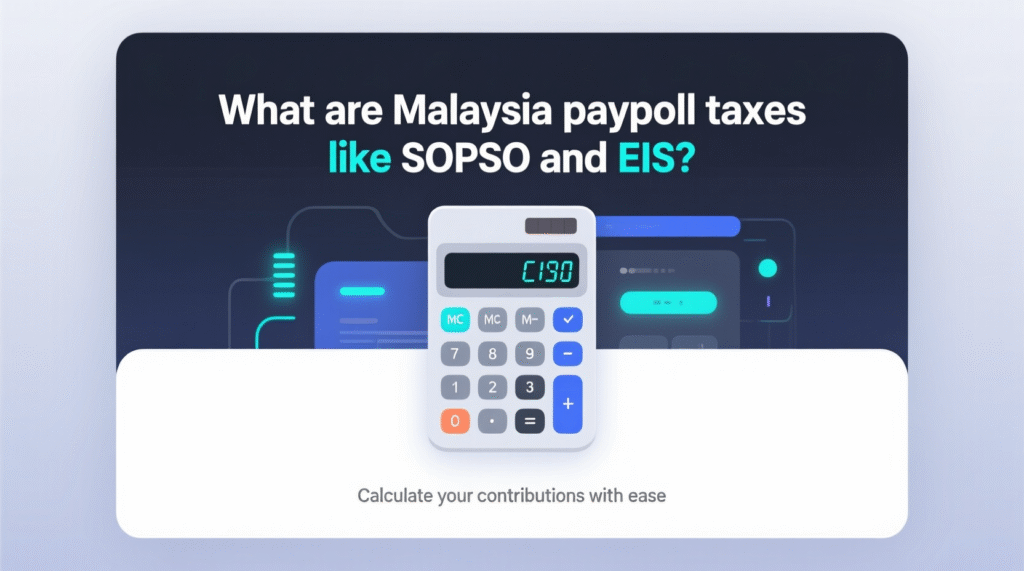
For anyone working in Malaysia, understanding your payslip deductions can be a real headache. You see acronyms like SOCSO and EIS and wonder, “What are these for? Are they taxes?” This content is for HR professionals, business owners, and employees who need a simple, clear explanation of these mandatory payroll contributions. The goal is to clear up the confusion and help you navigate Malaysian payroll with confidence.
What are SOCSO and EIS?
In Malaysia, SOCSO (Social Security Organization) and EIS (Employment Insurance System) aren’t traditional income taxes. They are mandatory social security contributions managed by PERKESO. These schemes are designed to provide a vital safety net, protecting employees against unexpected life events like workplace accidents, invalidity, or job loss.
| Contribution | What It Is | Who It’s For |
| SOCSO (PERKESO) | Provides financial protection for work-related injuries, invalidity, and death. It’s a long-term social security scheme. | All Malaysian and permanent resident employees in the private sector. |
| EIS | Offers temporary financial assistance and job search support to workers who are unexpectedly laid off or retrenched. | All Malaysian and permanent resident employees aged 18 to 60. |
How to Calculate SOCSO and EIS Contributions
Calculating these contributions is not based on a simple percentage. Instead, you refer to specific contribution tables provided by PERKESO. The rates are based on salary brackets, with a recently updated wage ceiling.
How do I calculate SOCSO?
The SOCSO contribution is shared between the employer and the employee. As of October 1, 2024, the wage ceiling for contributions was increased from RM5,000 to RM6,000.
- For employees under 60: The employer contributes 1.75% and the employee contributes 0.5% of the monthly salary.
- For employees aged 60 and above: Only the employer contributes, at a rate of 1.25%.
Real-Life Example: How do I calculate my SOCSO contribution if my salary is RM4,500?
You need to refer to the official SOCSO contribution table. For a salary in the RM4,400.01 – RM4,500.00 bracket, the contribution is a fixed amount, not a percentage calculation.
- Employer’s Share: RM77.35
- Employee’s Share: RM22.25
Total contribution for this salary bracket is RM99.60.
How to calculate EIS?
The EIS contribution is also a shared responsibility, with a fixed rate of 0.2% from both the employer and the employee. The contribution is capped at the same RM6,000 monthly salary ceiling as SOCSO.
Real-Life Example: How do I calculate EIS for an employee earning RM3,500?
The contribution is based on a fixed rate of 0.2%.
- Employer’s Share: RM3,500 x 0.2% = RM7.00
- Employee’s Share: RM3,500 x 0.2% = RM7.00
Total EIS contribution is RM14.00.
Key Benefits of SOCSO and EIS
- Financial Security: These contributions provide a financial lifeline during challenging times. For instance, if an employee is retrenched, they can receive a Job Search Allowance (JSA) from EIS for up to six months, with payments starting at 80% of their last-drawn salary.
- Welfare and Support: The benefits go beyond just money. SOCSO offers free medical care for work-related injuries and rehabilitation programs, while EIS provides career counseling, job matching, and training to help unemployed individuals find a new job faster.
Navigating these payroll details is critical for compliance and employee well-being. Using a modern HR and payroll solution like QuickHR or Talenox can simplify these calculations, ensuring you’re always compliant with the latest regulations and avoiding costly errors or penalties.
Frequently Asked Questions (FAQ)
Q1: What is the difference between SOCSO and EPF?
SOCSO provides social security protection against injuries, illnesses, and death. EPF (Employees Provident Fund) is a mandatory retirement savings scheme designed to help you save for your future.
Q2: Are foreign workers required to contribute to SOCSO and EIS?
Foreign workers are required to contribute to the SOCSO Employment Injury Scheme, but they are generally not covered by the Invalidity Scheme or EIS.
Q3: Can I get my money back from SOCSO or EIS if I resign?
No. Both SOCSO and EIS are insurance schemes, not savings funds. You cannot withdraw your contributions. The funds are used to pay benefits to those who qualify for claims.
Q4: How do I make an SOCSO or EIS claim if I lose my job?
You must apply for an EIS claim within 60 days of losing your job through the MYFutureJobs portal. You’ll need to provide your details and follow the steps for job matching and financial aid.
Q5: What happens if an employer doesn’t pay SOCSO and EIS?
Failure to pay mandatory contributions is a serious offense in Malaysia. Employers can face hefty fines, legal action, and potential imprisonment, in addition to late payment charges.
Willium is the creator of IncomeTaxCalculatorMalaysia.com, a trusted resource for accurate and easy-to-use tax calculation tools. With a deep understanding of Malaysia’s tax system, he helps individuals and businesses estimate their income tax with confidence. Willium is dedicated to simplifying financial decisions by offering clear, reliable tools and expert guidance, empowering users to stay informed and save time.
